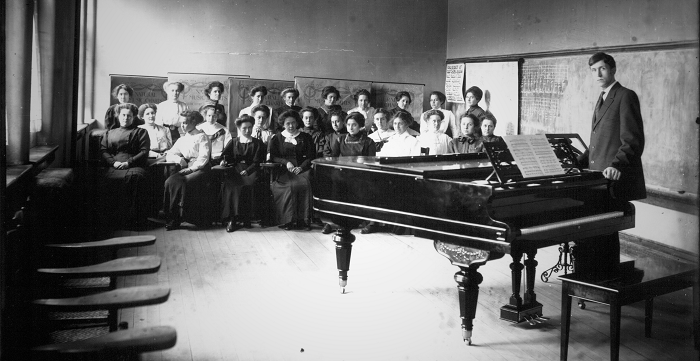It’s a common scenario — you’re stuck in a professional development session that doesn’t apply to you because your ensemble classroom isn’t like a math or language arts class. You want to work with these great teaching techniques, but the presenter just doesn’t understand the limitations and circumstances involved in the music classroom. Ultimately, your next rehearsal goes just like the last one (or one hundred) did. Ensemble directors shouldn’t be left out when it comes to including the best pedagogy in their teaching. Don’t be old fashioned — update your rehearsal technique.
Formative assessment is a well documented approach that can be difficult for ensemble directors to implement. Studies in the past 20 years (Harlen and James, Marzano, etc.) have consistently shown that formative assessment results in stronger student achievement. Music teachers, of course, care deeply about student achievement, and at concerts they literally share their students’ achievements with an audience. But judging everything by the performance means that ensemble students are still stuck with summative assessments, not formative ones. How can ensemble directors better implement formative assessment techniques?
Formative vs. Summative
“Formative” and “summative” evaluation are terms created by Michael Scriven in 1967 to explain how assessments can vary in terms of which information they gather and how that information is used by the instructor. John Hattie noted that the difference is “the timing of the interpretation and the purpose to which the information is used.” Scriven later refined the term, and today formative evaluation is commonly seen as an assessment done during the course of learning that shows a student’s current point of development and informs educators about how teaching could be altered or improved. Summative assessment, on the other hand, is performed at the end of a learning activity to provide a measure of student achievement.
Perhaps the most important difference is the timing of the assessment. Because formative assessment occurs throughout the learning process, it is more effective at showing teachers how students are performing, rather than offering a snapshot of student achievement at the end of a learning period. The way feedback is implemented after the evaluation also differs: formative assessment implies that educator and student will return to the material for further growth, while summative assessment offers a kind of “final judgement” on the student’s learning.
Formative assessment has a number of other advantages, including:
- Improving students’ ability to assess themselves and their peers
- Developing students’ understanding and awareness of their own learning
- Shifting focus from achievement to the learning process
- Providing opportunities for educators to help students who are falling behind
Formative Assessment in the Music Classroom
So how does this apply to the band (or orchestra or choir) room? In some ways, ensemble teachers are already masters of formative assessment. Directors spend rehearsals constantly listening and providing feedback — “Trombones, watch the dynamics at measure 42,” “Sopranos, give me a longer vowel sound on ‘Sleeeeeep,’” etc. Unfortunately, even though the day-to-day activities are often formative, the actual assessments taking place in ensemble classrooms are usually summative. An audition or chair test is arguably the most summative assessment possible. The educator takes a snapshot of student achievement after a period of practice, compares it to other students, and then provides future opportunities to students based on the assessment.
I believe some simple changes can bring formative assessment to the audition process and improve the formative assessment already taking place in rehearsal.
Auditions and chair tests are fine as a “final exam,” but teachers can improve the skills of every student by incorporating formative assessment during the instruction that leads to the audition. Audition prep provides a great way to incorporate peer assessment, a key type of formative evaluation. Improve your students’ performance practice by having them play audition materials for each other. Not only does this help the performer practice more than the notes and rhythms, it also gives the other students an opportunity to develop their ears, offer constructive feedback to peers, and participate in the learning process. Ask student evaluators questions like:
- Which performance did you prefer? Why?
- Which musical elements (intonation, articulation, tone quality, etc.) were especially good?
- Which musical elements needed work? Which of our in-class warm-up exercises should this person work on to practice those skills?
This last question is especially well-suited to formative assessment. Not only did the student evaluator develop critical listening skills, he or she is engaging with the learning process by thinking about which exercises generate positive results for the deficiency. If a brass player is having tone production issues, hearing from a peer that it’s time to do more long tones is more effective than getting to the audition with bad tone and has the added benefit of getting peers involved.

Rehearsal Techniques
Rehearsal techniques can also be easily customized to include formative evaluation techniques. As I mentioned earlier, many school ensemble rehearsals are already somewhat formative because they offer feedback throughout the learning process — but rehearsal procedure can become even more formative.
When directors give feedback to students, it’s often after the fact — students have to play something before it can be evaluated. However, students sometimes are performing without a clear sense of what the teacher is listening for. When expectations are clearly laid out ahead of time, students can take a more active role in their own learning by focusing their energy on a single skill.
Of course, new mistakes pop up in rehearsal all the time and need to be addressed. Rather than simply calling these out, take advantage of the formative strengths of an ensemble rehearsal and modify your future teaching. Make sure that the next day’s warm up includes exercises that specifically target things that didn’t go well in the last rehearsal. If articulations were inconsistent and needed more work, reinforce the skill by including an articulation exercise the next day.
The benefits of formative assessment have been well documented and can be easily incorporated into your ensemble classroom. Don’t get stuck using old-fashioned methods!
In addition to his role as MakeMusic’s social media manager, Ryan Sargent is an active teacher and performer in the Denver-Boulder metropolitan area and a member of the music faculty at the Metropolitan State University of Denver. A graduate of Baylor University, he has studied jazz composition and improvisation with Art Lande and Alex Parker.

